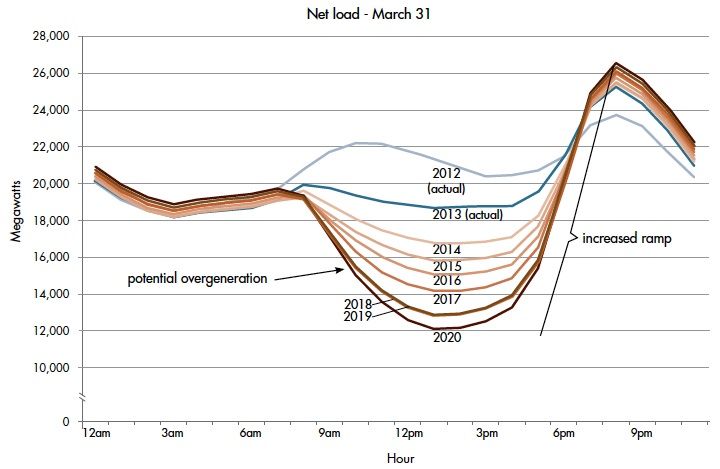If you are active in the power sector, you likely know about the "duck curve."
If you work in solar power, the duck curve is proof of your growing industry’s ability to meet early afternoon peak power demand. If you work in efficiency, storage, or demand response, the curve is an opportunity to prove your value during fast-ramping periods in the late afternoon. If you work for a utility or regulatory agency, the duck is a triple challenge -- straining your grid, threatening profits, and challenging old system control and management models.
Thankfully, the duck curve is perfectly solvable. A set of proven strategies can teach the duck to fly. These strategies (explained below) tighten the duck’s belly and flatten its neck -- moving it from a “sitting duck” position to a “flight” pose, thereby helping solve one of the more pressing problems facing the power sector.

Source: CAISO
In the course of analyzing the duck curve, we’ve learned a lot about how far the grid has come. We’re now even more convinced that the duck curve presents a historic opportunity to modernize the grid, increase the penetration of pollution-free, clean energy resources, and make our homes, buildings and businesses more energy efficient.
It’s also clear that the energy technologies and grid are changing faster than anyone anticipated, creating new opportunities for managing this transition. Here are some of them.
Peak-oriented renewable energy is the most valuable
Many states have renewable portfolio standards that set baseline minimums for renewable energy penetration, but don’t require consideration of when such assets are producing their maximum power. By targeting their acquisition of renewables to those projects that offer the most well-timed production -- in particular, afternoon or evening-peaking wind -- utilities and grid managers can shave significant load off the duck’s neck.
Water is a battery, and we should use it that way
Around the world, water is already used as a battery to store potential energy, heat or cold for later use in various applications. There are three ways utilities can put water to use in service of the duck, and save themselves the need for new generation assets.
Water and wastewater pumping consume 7 percent of all electricity in the U.S., but such pumping is usually not coordinated as a part of efforts to manage load and shift peak demand. By offering incentive pricing to large water managers, such as water and sewer districts, utilities can turn these assets into a form of “reverse battery,” scheduling pumping demand for periods of high renewable energy production -- such as the solar daytime peak or wind’s typical nighttime peak.
The ability to load-shift demand for air conditioning through the production and storage of ice and chilled water is substantial, and offers a pathway to significantly shift peak AC load away from the late afternoon peak toward periods of high renewable production. But fewer than 1 percent of U.S. air conditioning systems have any thermal storage.
Similarly, controlling water heaters to ensure they switch on during periods of high daytime solar production or high nighttime wind production offers the opportunity to integrate up to 100,000 additional megawatts of solar and wind energy in the U.S. grid. Switching them off during peak load periods avoids the need for expensive peaking generation, and customers can still use the stored hot water for showers and laundry.
Some resources are less valuable than we previously assessed
West-facing solar panels do produce a more valuable output, but the incremental value turns out to be relatively small. And solar thermal power plants do allow for delayed generation into the evening, but remain expensive while the cost of PV solar has declined dramatically.
While some parties focused on system reliability issues may argue that variable renewable energy can only be relied on for a small portion of daily energy requirements, the 10 low-carbon strategies identified in Teaching the Duck to Fly (read them all here) demonstrate how loads can be adapted to those resources to assure reliable and economical service to consumers.
Many are already used on a modest scale, and others have been proven in pilot programs. None require new technology. While these strategies involve commercially available technologies, the technologies -- at least to date -- have not been aggressively deployed.
The strategies not only enable substantially greater renewable energy integration, they enhance system reliability and reduce generation, transmission, distribution capital costs and fuel expense by modifying the load profiles and better utilizing existing assets. Not every strategy will be applicable to every region or utility around the country, and every region will have additional strategies suitable for their particular markets.
The duck curve -- while it challenges us to be creative and innovative -- is certainly not a threat to an economical, reliable and environmentally friendly grid.
***
Jim Lazar is a senior advisor at the Regulatory Assistance Project.



